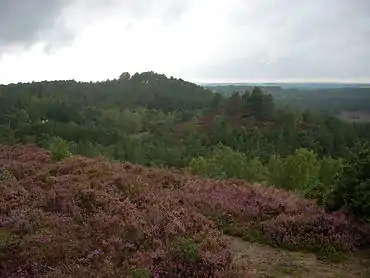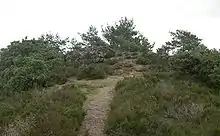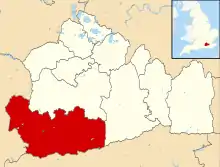Devil's Jumps, Churt
The Devil's Jumps are a series of three small hills near the village of Churt in the county of Surrey in southern England.[1] In the 18th century, the hills were known as the Devil's Three Jumps.[2] The Devil's Jumps are linked to a body of folklore relating to the surrounding area.[1] The highest of the three Jumps is Stony Jump.[1] Middle Devil's Jump measures 60 feet (18 m) high and once supported an observatory built by 19th century British astronomer Richard Christopher Carrington.[3]

The hills are outcrops of an ironstone variety of sandstone of the Folkestone Beds of Lower Greensand set among acidic heathland.[4] The three hills are formed of an ironstone known locally as carstone, marginally distinct from Bargate stone, strongly cemented with iron making it resistant to erosion by the elements.[5]


The first mention of the Devil's Jumps appears to be on a map by John Rocque, dating to 1765.[6] William Cobbett mentioned the Devil's Jumps in his Rural Rides, first published in 1830.[7] Of the hills he says:
At Churt I had, upon my left, three hills out upon the common, called the Devil's Jumps...in the shape of three rather squat sugar-loaves, along in a line upon this heath...[with] a rock-stone upon the top of one of them as big as a Church tower...
— William Cobbett, Rural Rides 1830, 2001, p.116.
Folklore
The Devil's Jumps are linked to a variety of local landmarks by folklore, including Mother Ludlam's Cave near the ruins of Waverley Abbey, the Devil's Punch Bowl at Hindhead, the village of Thursley and the parish church at Frensham.[2] The folklore includes various tales. One states that the Devil used to amuse himself by leaping from the top of each hill to the next.[2] This annoyed the god Thor who picked up a boulder and threw it at the Devil, causing him to flee and leaving the boulder at the Devil's Jumps.[2] This same story is told of the Devil's Jumps near Treyford on the South Downs in West Sussex, but it is likely to have originated at the Devil's Jumps in Surrey.[2] The inclusion of the pagan god Thor in the tale is likely to have taken place in the early years of the 20th century, since local historian George Clinch mentioned the Jumps and the pagan derivation of the Thursley placename without linking either when he wrote in 1895.[2]
Two divergent, possibly linked, narratives were collected in the 19th century:
- Mother Ludlam (who was a witch) had her cauldron stolen by the Devil, who made off with it, with the witch following behind on her broomstick.[8] Every time the Devil took a great leap he kicked up a hill, and these hills are the Devil's Jumps. He left the cauldron on Kettlebury Hill, from where it was recovered and put in Frensham church for safekeeping. When the Devil disappeared, he left the valley of the Devil's Punch Bowl.[8]
- A great boulder was on one of these hills, where a person needing any tool, even a yoke for oxen by prayer and touching the boulder would receive it, provided they promised to give it back. Later a cauldron was requested, kept in Frensham's church beyond its use and so the mystical loan facility came to an end.[9]
Relative prominence
The Jumps protrude 121 metres (397 ft) above sea level or 34 metres (112 ft) above the col (nearest notch/gap). This places them 32nd among Surrey Hills and narrowly among the 34 Surrey Hills above 100 metres (330 ft) above sea level with only 36 hills in the county listed by the national hill-climbing database.[10]
Notes
- http://www.weyriver.co.uk
- Westwood & Simpson 2005, p.713.
- Churt Parish Council.
- Gahan 2006, p.10.
- Ashurt & Dimes 2004, p.62. Gahan 2006, p.10.
- Smith 2005, p.60.
- Cobbett 1830, 2001, p.116.
- Alexander 1986, 2003, pp.29-30.
- H.E. Malden (editor) (1906). "Parishes: Frensham: Churt". A History of the County of Surrey: Volume 2 p.613. The Internet Archive. Retrieved 25 November 2013.CS1 maint: extra text: authors list (link)
- Database of British and Irish Hills Retrieved 2015-03-06
References
| Wikimedia Commons has media related to Devil's Jumps, Churt. |
- Alexander, Matthew (2003) [1986]. The Fair Maid of Guildford and other Surrey tales. Newbury, Berkshire: Countryside Books. ISBN 1-85306-827-6. OCLC 59270415.
- Ashurt, John; Francis G. Dimes (2004). Conservation of Building & Decorative Stone. Oxford, UK and Burlington, Massachusetts, USA: Elsevier Butterworth-Heinemann. ISBN 0-7506-3898-2. OCLC 39341812.
- Churt Parish Council (n.d.). "A Brief History of Churt". Churt Parish Council. Archived from the original on 21 July 2011. Retrieved 7 August 2010.
- Cobbett, William (2001) [1830]. Rural Rides. London, UK: Penguin Classics. ISBN 0-14-043579-4. OCLC 47150334.
- Gahan, John (October 2006). "The Western Weald field trip for the Devonshire Association – 12th-14th May 2006" (PDF). Farnham Geological Society Newsletter. Farnham Geological Society. 9 (3). Archived from the original (PDF) on 3 October 2011. Retrieved 7 August 2010.
- Smith, Gavin (2005). Surrey Place-names. Loughborough, UK: Heart of Albion Press. ISBN 1-872883-84-2. OCLC 255038836.
- Westwood, Jennifer; Jacqueline Simpson (2005). The Lore of the Land: A Guide to England's Legends, from Spring-Heeled Jack to the Witches of Warboys. London, UK: Penguin Books. ISBN 978-0-14-100711-3. OCLC 61302120.
- weyriver.co.uk (2009). "The River Wey South Branch:On to Frensham and Tilford". Wey River. Archived from the original on 19 July 2011. Retrieved 5 August 2010.
